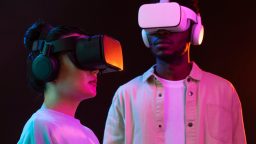In recent years, robotics has emerged as a groundbreaking field, not only transforming industries but also revolutionising healthcare. Robots in healthcare are no longer a futuristic concept; they are already saving lives and improving the quality of care patients receive. From surgical robots to rehabilitation aids, robotic technology is offering innovative solutions to longstanding challenges in the medical world. As we move forward, the integration of robots in healthcare promises to continue advancing, enhancing patient outcomes, and making healthcare more efficient and accessible. Let’s dive into how robots are being used in healthcare, the benefits they bring, and the future of this exciting technology.
Robots in Surgery: Precision and Minimally Invasive Procedures
One of the most well-known applications of robotics in healthcare is in surgery. Robotic surgery systems, such as the da Vinci Surgical System, have revolutionised the way surgeries are performed, offering greater precision, flexibility, and control than traditional methods. These robotic systems are typically controlled by surgeons from a console, with the robot’s arms performing the intricate tasks.
Robots in surgery enable minimally invasive procedures, where smaller incisions are made, leading to less pain, faster recovery times, and reduced risk of infection. For patients, this means quicker return to daily activities, fewer complications, and often shorter hospital stays. Robotic surgery is being used for a variety of procedures, including cardiac surgery, urological procedures, gynaecological surgeries, and orthopaedic surgeries.
Robotic Rehabilitation: Helping Patients Recover
In addition to assisting in surgeries, robots are also making significant strides in rehabilitation. Robotic exoskeletons and robotic-assisted therapy devices are helping patients recover from strokes, spinal cord injuries, and other neurological disorders by providing targeted therapy and support during recovery.
For example, exoskeletons are wearable robotic suits that help patients with lower limb paralysis stand, walk, and regain mobility. These devices are controlled by the patient or therapist and use motors and sensors to assist with movement. Such technology not only aids in physical rehabilitation but also provides emotional benefits by offering patients a renewed sense of independence and improving their quality of life.
Additionally, robot-assisted therapy systems, such as robotic arms used in physical therapy, help patients with joint and muscle rehabilitation. These systems are often designed to perform repetitive tasks, improving motor function and helping patients regain their strength and mobility in a controlled, systematic manner.
Robots in Patient Monitoring: Enhancing Care and Reducing Human Error
Robotic technology is also improving patient care through monitoring systems that provide real-time data and alerts to medical staff. Robots equipped with sensors and artificial intelligence (AI) can track a patient’s vital signs, detect abnormalities, and even predict potential complications before they become serious.
For example, robots can be used to monitor blood pressure, heart rate, respiratory rate, and oxygen levels. These monitoring systems can send immediate alerts if something is wrong, allowing healthcare providers to respond quickly, often preventing a medical emergency. Additionally, robots equipped with AI can help detect signs of sepsis, infection, or organ failure, enabling earlier intervention and improving patient outcomes.
In the future, robots might even take on more advanced roles in patient monitoring, including remote monitoring for elderly or homebound patients. With telemedicine and robotic systems in place, healthcare providers can keep track of patients’ health remotely, ensuring continuous care without requiring frequent in-person visits.
Robots in Delivery and Assistance: Improving Hospital Efficiency
Robots are also playing an important role in improving hospital efficiency. Delivery robots, for instance, are used in hospitals to transport medications, documents, and even meals to patients. These robots navigate hospital corridors autonomously, reducing the workload on hospital staff and ensuring that essential items are delivered promptly.
In some hospitals, robots are also used for disinfection. Robots equipped with UV-C light can disinfect rooms, operating theatres, and other areas of the hospital, reducing the spread of infections and providing an additional layer of cleanliness, particularly in high-risk environments.
Robots for Mental Health and Elderly Care
Another exciting development is the use of robots in the field of mental health and elderly care. Robots like PARO, a therapeutic robotic seal, are being used to provide companionship to elderly patients, particularly those with conditions like dementia or Alzheimer’s disease. PARO, which mimics the behaviour of a real baby seal, has been shown to reduce stress, anxiety, and feelings of loneliness in elderly patients, offering comfort and improving their overall well-being.
In mental health care, robots are also being used to assist in cognitive behavioural therapy (CBT) and other forms of therapy. Robots can engage patients in conversation, providing an additional level of support and enabling patients to practice their coping skills in a controlled, non-threatening environment.
The Future of Robots in Healthcare
The potential for robots in healthcare is vast, and we are only scratching the surface of what these technologies can do. As artificial intelligence (AI), machine learning, and robotic technologies continue to improve, robots in healthcare will become even more advanced and capable. In the coming years, we can expect robots to play an increasingly important role in personalised medicine, with robots capable of carrying out custom treatments tailored to each patient’s genetic profile or specific health condition.
Furthermore, as robotics continues to evolve, we may see the development of more autonomous robots that can perform entire surgeries or administer treatments without direct human intervention. These robots will be able to process vast amounts of data, analyse patient conditions in real time, and make decisions with a level of accuracy and speed that humans cannot match.
Challenges and Considerations
While the benefits of robots in healthcare are clear, there are challenges to overcome. One major concern is cost. Robotics technology can be expensive, and many healthcare systems may find it difficult to justify the investment, especially in low-resource settings. Additionally, there are concerns about the ethics of relying on robots for medical decision-making, as well as potential job displacement for healthcare workers.
It is also crucial that data privacy and security measures are in place, especially when dealing with sensitive patient information. Ensuring that robots are integrated into healthcare systems safely and responsibly will be vital for their widespread adoption.
Conclusion
Robots are already saving lives through their innovative applications in healthcare, and their impact will only grow in the coming years. From surgical robots and rehabilitation aids to monitoring systems and assistance for the elderly, robotic technology is transforming the way we approach patient care. As we look to the future, robots in healthcare will continue to play a crucial role in improving medical outcomes, enhancing efficiency, and offering new solutions to old problems. With continued innovation and thoughtful integration, robots are set to revolutionise healthcare and save even more lives.





